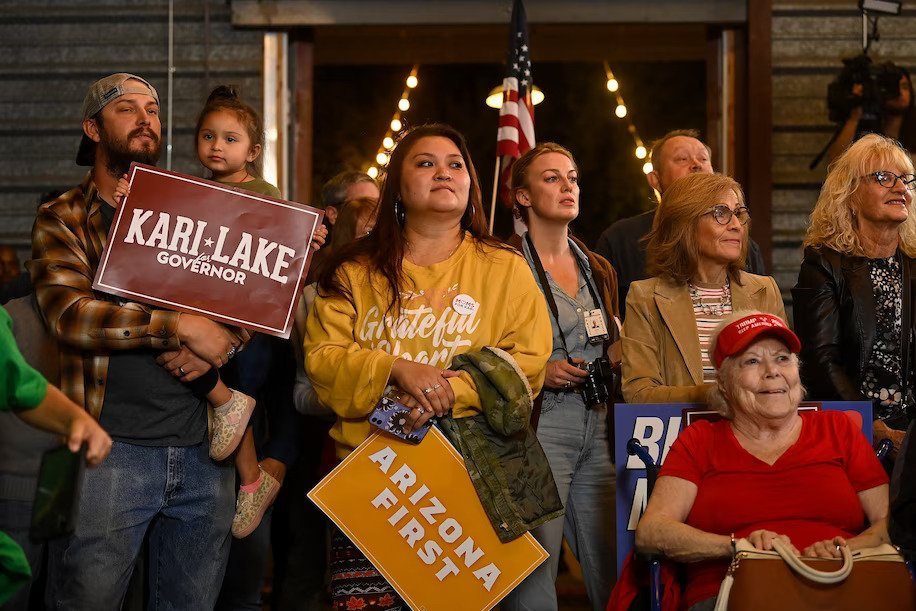This Arizona town captures America’s deepening rural-urban divide



People listen to Republican candidate for Arizona governor Kari Lake at a campaign rally in Queen Creek, Ariz., on Nov. 6. (Joshua Lott/The Washington Post)
by Henry Olsen
QUEEN CREEK, Ariz. – Arizona’s rapid transformation from a Republican bastion to a swing state is largely a story about the divergence between suburban and rural values. Nowhere is this more evident than in this fast-growing exurban town.
Queen Creek was once a small farming community. As recently as 1990, a mere 2,500 people called it home. Today, more than 68,000 people do, and thousands more arrive each year. It’s the third-fastest growing city in the United States and is projected to have 175,000 residents when fully developed.
It’s easy to see the attraction if you drive around, as I did this past week. Houses are new, cheap and plentiful. Sparkling new strip malls offer convenient shopping and dining within a few minutes’ drive. The city, located on the edge of the Phoenix metro area, also offers pristine mountain views and open space. It’s a magnet for millennials who want to raise their children in a safe, comfortable community.
The tech industry has driven much of this growth. Intel, the big semiconductor manufacturer, and Boeing are the town’s largest employers, attracting an educated, affluent workforce. Median income is more than $100,000, and 77 percent of residents 25 or older have at least attended college. Intel’s new $20 billion expansion of its nearby plants will only further supercharge this explosive growth.
This suburban future stands in stark contrast to Queen Creek’s rural past. It still pays homage to that legacy, hosting an annual stop on the professional rodeo tour called Roots N’ Boots. The festival, which I recently attended, is about as foreign an environment to the city’s tract home world as one can imagine.
Stetson hats and cowboy boots were de rigueur for attendees. Small, individually run businesses hawked their wares with a strong tilt toward rural-themed jewelry and accoutrements. Country music played in the background as people sampled barbecue, tacos and Italian ice. A few stalls had T-shirts from the popular television series “Yellowstone” for sale, and the bar served Coors Banquet beer rather than fancy craft brews.
The rodeo itself was a paean to the sort of values one associates with tight-knit rural communities. The announcer frequently praised military service members for their sacrifices in keeping us free. An evangelical pastor who runs the Heart Cry (Cowboy) Church, which holds services in the equestrian center once a month, delivered the invocation in Jesus’ name. It was wholesome and quaint in the way anyone who has watched old Westerns would find comfortably familiar.
The cultural change taking place in Queen Creek does not share the violent undertone of the “Yellowstone” story line, but the conflict in values that drives that show is manifest. People in small towns know one another much more fully than those in suburban subdivisions. Working on a team at Intel is nothing like roping a calf on a cattle ranch.
That’s becoming evident on the area’s voting patterns. Queen Creek remains a highly Republican town, giving former president Donald Trump 67 percent of the vote in 2020. But other, more rural communities in the area such as Wickenburg and Black Canyon City were even a deeper shade of red, giving him more than 70 percent. One can expect Queen Creek to slowly tilt away from the GOP as more college-educated Intel engineers buy the new homes that are rapidly transforming the desert.
This cultural conflict is not unique to Arizona — or even the United States. Canada is seeing a deepening rural-urban divide in its voting, with populist right-wing parties winning 10 percent or more in ridings in rural Ontario or the prairies in the 2021 federal election. Australia’s most recent election also revealed a sharper urban-rural divide than in prior years. This month’s Dutch regional elections were won by a rural protest party, the FarmerCitizen Movement, which arose in opposition to the urban-dominated government’s climate change policy.
Managing this divide will be a challenge for both political parties in the United States. Democrats are increasingly becoming an urban-only party and would lose almost all of their rural support if Hispanics start to follow White voting behaviors. Republicans now have so much rural support that their candidates often forget they have to win suburban votes, too. Failure to do this, not voter fraud, is why Republican Kari Lake lost her bid to become governor last November.
The new America is being built all around us. If its leaders do not also construct an honored place for the old America on whose foundation this is being built, our divides are likely to deepen and intensify even more.

